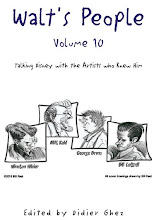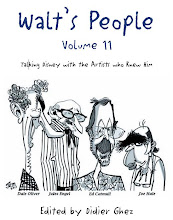
Unfortunately Walt's People - Volume 4 will be late by at least one month. I never release any volume before the "founding fathers" of the project send me their detailed revisions, and one of the most important members of the group (as far as revisions are concerned) is hard at work on various book projects and was understandably unable to give me his feedback on time. I take the news very positively as Volume 4 should not be delayed later than December or January apparently, but even more so because the reason it is late is one of the best that could be: we will soon see a few more in-depth, well-researched works about fascinating aspects of Disney history.
To reward your patience, here is my introduction to this upcoming volume.
I like to write Walt’s People introductions while traveling, be it on business or on vacations. This time I am on vacation, on the small Greek island of Amorgos. What makes this a special occasion, though, is the fact that this trip marks an important break in my life: After having worked for 10 years for The Walt Disney Company, I have decided to move to Warner Bros. No worries, though. I will carry on working on Walt’s People during my free time; this project was never linked to my professional life. It was and remains a “labor of love.”
The move to Warner, however, becomes meaningful when it makes me seriously think about launching a new book series, in parallel to Walt’s People: Bugs’ Buddies (my thanks to Steve Schneider for suggesting this title), which would focus on Warner animation artists. Will I find an editor for this project as passionate about Warner animation as I am about Disney? Or will I end up launching this project myself someday? We will see.
What is certain is that this project is also long overdue and would serve as a crucial complement to Walt’s People. We already saw in past volumes that understanding the creative life of Disney artists like Grim Natwick, Friz Freleng or Frank Tashlin is close to impossible without taking into account their experiences at other studios. In addition, the links between Warner’s animation history and Disney are many and are often fascinating: From the creation of what would become the Warner animation studio by Walt’s pre-Mickey Mouse artists, Rudy Ising and Hugh Harman, to the brief stint of Chuck Jones at Disney in 1953, and through the various references to Disney within Warner cartoons, like the caricature of Ward Kimball in Hiawatha’s Rabbit Hunt (1941).
Once again, time will tell if I manage to find an enthusiast editor for Bugs’ Buddies. Regardless of what happens, however, the momentum is there, as more and more serious animation historians have recently caught a surprising new wind. Something extremely exciting is going on. CartoonBrew’s editor Jerry Beck summed it up: “There is a quiet revolution happening in the animation community, and it's all thanks to the Internet. With the explosion of blogs in the past year, a wide range of difficult-to-find historical material is becoming publicly available for the first time. The availability of this material, which includes artwork, documents, films, and analysis, doesn't only benefit historians; it also benefits artists in all parts of the world, who now have open access to examples of quality animation.” A few years ago Michael Barrier, the godfather of animation history and my main influence when starting Walt’s People, launched his blog; just over a year ago Clay Kaytis started Animation Podcast, a site solely dedicated to great interviews with animation artists; a few months ago, Animation Blast’s editor, Amid Amidi, created Cartoon Modern, a blog that complements his book of the same title and offers extremely in-depth insights into the lives of many key animation artists, quite a few of whom worked for Disney.
And then things went wild! Animator Jenny Lerew posted more amazing Freddy Moore artwork (from the collection of James Walker) than I had seen in years (and that screams to be collected in book form), along with rare “animator drafts” that give an idea of which animator worked on which scene within Disney shorts and features. Danish director Hans Perk, from A. Film,[released many more of those “animator drafts,” and animation historian Mark Mayerson used them to analyze the shorts and features in an unprecedented way and shed fascinating new light on the work of many of Walt’s people. In other words, the more information released, the more people decide to release new information, leading to fresh understanding and knowledge. Of course, this also allowed us to identify new sources of unpublished interviews with Disney artists that will soon appear in Walt’s People: Freddy Moore’s assistant Ken O’Brien by Jenny Lerew, Art Stevens by Pete Docter…
The “quiet revolution” that we see happening on the web brings me to a similar process experienced by Walt’s People. Many key Disney historians have recently given me the authorization to publish their work, as they see this as a way to protect material that was at risk of being lost or irrevocably damaged—some interviews were even preserved in reel-to-reel format! In this volume, Charles Solomon, author of one of my favorite books on Disney animation, The Disney that Never Was, is one of the new key historians joining the Walt’s People team.
Another new participant is Joe Adamson. His oral history with Dick Huemer is the keystone of this volume. I had admired this interview for years after having read excerpts of it in Funnyworld and had always dreamed of releasing a Disney-related uncut version in Walt’s People.
Of course, focusing on Huemer’s career would not have been complete without tackling in-depth the career of his creative alter-ego Joe Grant. Who better than Michael Barrier to draw interesting and surprising answers from such a notoriously tough interviewee? The Huemer focus also allows us to welcome the third of Walt’s People’s new contributors, Brian Sibley, who appears in this volume as both interviewer and interviewee.
There are many more exciting features in this volume, including a surprising new look at the career of Peter Ellenshaw; the seminal interview with Roy Williams by Don Peri (another important new member of the Walt’s People team), who shows us who the Big Mouseketeer really was; another foray into the world of Disney comics with Dick Moores and Roger Armstrong, thanks to comics expert Alberto Becattini; the second part of Celbi Pegoraro’s interview with Floyd Norman; an interview with Eric Goldberg; and a look at the abandoned project Mary Poppins Comes Back.
My own favorite from a historical point of view, however, is Dave Smith’s chat with Lou Debney, as it gives us a first glimpse at the Disney Studio during WWII, a subject that we will explore in much more detail in Walt’s People - Volume 5.
Not enough scope yet for one single volume? So before surrounding ourselves, once again, with Walt’s people, let’s meet Walt’s first star…
Didier Ghez
Amorgos, June 2006






















1 comment:
Great introduction, Didier, but it only makes me sorry that volume 4 will be delayed. I guess I'll just have to be patient.
Post a Comment